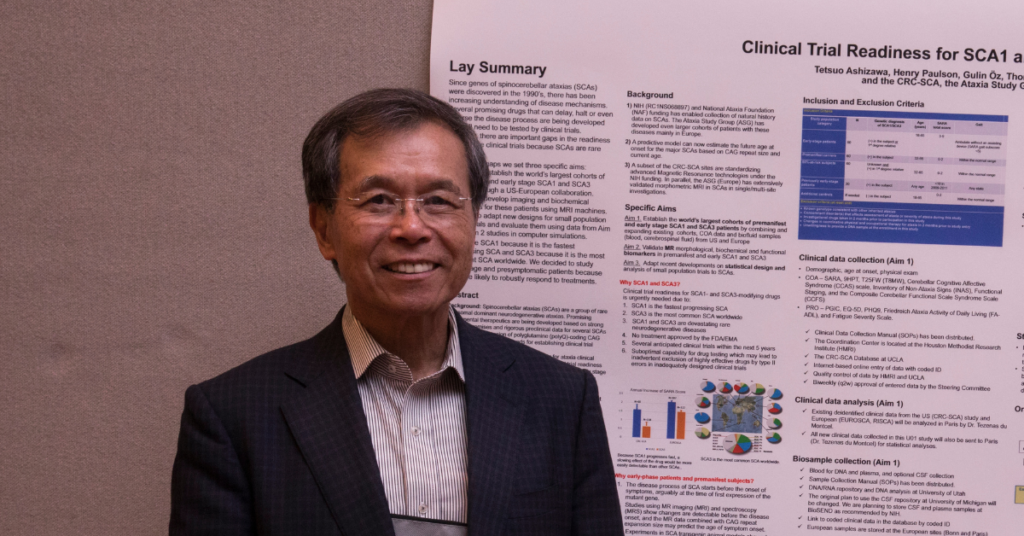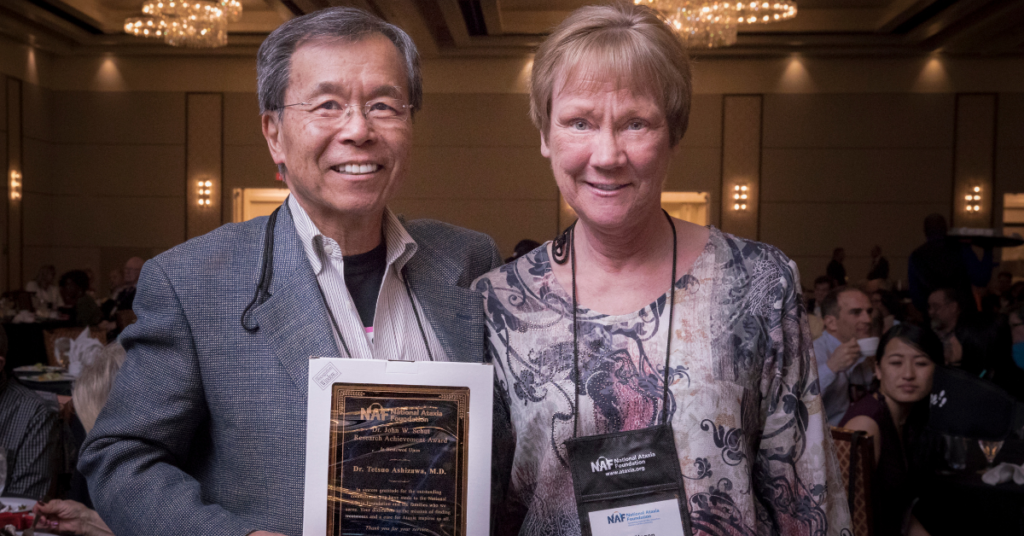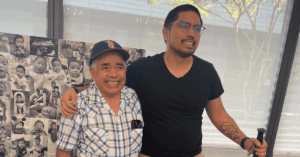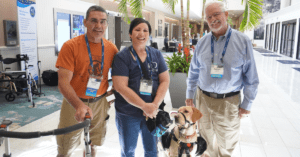
While some begin their careers with a specific specialization – ready to focus on making a difference in a certain field – Dr. Tetsuo Ashizawa’s path to becoming an internationally acclaimed physician scientist specializing in Ataxia was anything but predetermined.
Born in Tokyo in 1948, Dr. Tee, as he prefers to be called, lived in Japan during his childhood and attended medical school at Keio University. He moved to the United States for his residency training and finished training at Baylor College of Medicine. He began his career as a neuromuscular clinical specialist working in a lab, conducting experiments, rather than interacting with patients.
“I was a lab rat, most of the time, instead of a clinician,” he laughs.
His first focus was researching myasthenia gravis, a chronic autoimmune disorder in which the skeletal muscles are weakened by antibodies that destroy the communication between nerves and muscle.
“But I sort of failed in that research,” he admitted. “So it wasn’t a success story.”
However, as fate would have it, Dr. Tee was destined to have success researching other disorders instead.
A New Path and a Growing Network
Soon after concluding his work on myasthenia gravis, the Muscular Dystrophy Association approached the team at Baylor College of Medicine. They were hoping to clone the gene for myotonic dystrophy, as it was believed at the time to be a single disease entity that progressively weakened muscles and is the most common adult form of muscular dystrophy.
Dr. Tee joined an international team composed of British, Dutch, Australian, Canadian and American researchers. Just a few years later, the collaboration resulted in the successful cloning of the gene that causes myotonic dystrophy.
He began working to identify the gene for Huntington’s disease, an inherited disorder that causes neurons in parts of the brain to gradually break down and die, resulting in the loss of control of voluntary movements.
The significance of this event is that Huntington’s disease is not a muscular dystrophy but a movement disorder where ataxic disorders are classified. Dr. Tee started his studies on Huntington’s disease because the genetic mutation was a triplet (CAG) repeat expansion – like myotonic dystrophy’s triplet (CTG) repeat but different sequence of the repeat unit and in a different gene.
Focusing on Ataxia
It was the early 1990’s when Dr. Tee’s research spread within the medical scientific community and he began working more closely with other scientific researchers. While he had known Dr. Huda Zoghbi from his residency at Baylor College of Medicine, he was soon introduced to another giant in the Ataxia research field: Dr. Harry Orr at the University of Minnesota. Dr. Zoghbi and Dr. Orr had recently discovered the genetic mutation that contributes to Spinocerebellar Ataxia type 1, or SCA1. The SCA1 mutation turned out to be another CAG repeat expansion, like it is in Huntington’s disease, but the CAG repeat was located in a different gene now known as ataxin 1 (ATXN1).
Around the same time, Dr. Tee received an email from a Houston-based private practitioner who had identified a patient and their family who had Ataxia. Dr. Tee saw an opportunity to clone the gene using this patient’s family.
Dr. Tee successfully applied for a grant funded by the Oxnard family through the National Ataxia Foundation, and within three years, the team was able to successfully clone the gene. At that time, they discovered the patient’s gene mutation was different from previous Ataxia genetic mutations, and their findings helped to determine that Ataxia was a very unique disease. This mutation was an expansion of an ATTCT pentanucleotide (five letters) repeat and the first of an increasing number of similar repeat expansion Ataxias, such as SCA27B, SCA31, SCA37, and CANVAS/RFC1.
Intrigued by this result, Dr. Tee began expanding his network so he and other researchers could share their discoveries regarding Ataxia. “We named it the Cooperative Ataxia Group or CAG— kind of a cute name,” he says, alluding to the play on words because many SCA’s have been found to have a CAG repeat-expansion mutation.
The Collaboration Continues
It was then that the National Institute of Neurological Disorders and Stroke (NINDS), an institute of the National Institutes of Health (NIH), sent a request for applications to further our understanding of neurological diseases.
“At that time, I had no clinical trial expertise – more laboratory expertise – but I knew how to see patients and how to evaluate them,” he remembers.
With that experience and a desire to help the Ataxia community discover much-needed answers, Dr. Tee helped to successfully obtain a grant to study Ataxia through the NINDS.
Over the years, the group evolved both in name—as CAG became the Clinical Research Consortium for Studies of Cerebellar Ataxia (CRC-SCA)—and focus, as more was discovered about Ataxia. However, the collaboration and cooperation between the physician researchers remained constant.
When another National Institutes of Health (NIH) grant opportunity appeared in 2018, Dr. Tee reached out to his colleagues to coordinate the possibility of working together. The grant application was a success, and the project nicknamed “READISCA” began. The project resulted in 71 institutions around the world participating in a five-year clinical trial readiness program—the largest cohort of patients who were mostly facing the earliest stages of Spinocerebellar Ataxia.

Pictured above: Dr. Tee Ashizawa (left) being presented with NAF’s Dr. John W. Schut Research Achievement Award by our former Research Services Director, Sue Hagen (right).
Keeping Patients First
Over the years, Dr. Tee has served on multiple grant review panels, including NIH study sections, and on the scientific advisory boards of the National Ataxia Foundation, the Myotonic Dystrophy Foundation, and the Association Française contre les Myopathies.
He has published over 200 peer-reviewed original papers on basic and clinical research. He has led international Ataxia clinical research projects, such as NIH-funded READISCA.
Yet, when reflecting on his internationally acclaimed career, Dr. Tee says he was never motivated by seeing his name on a paper or in a journal.
“Every day, I see patients with this chronic disease. Year after year, I see these people, some children and young people, going down with Ataxia. And as a human being, you really want to do something about that – even if you cannot really do anything because we don’t have a cure, yet,” says Dr. Tee.
“Physical therapy, exercise programs, treatment of depression, and just talking to the patient—it all helps. It means something to just be there, without talking sometimes and other times, sharing the research we’re doing and providing encouragement that the future may be better. That’s what kept me going,” he concludes.
As he approaches retirement, Dr. Tee says that he’s not interested in leaving a legacy in the world of Ataxia research.
“There are a lot of giants in the field, and a lot of the younger people have innovative ideas, high capabilities, and immense talent. I’ve been one of the cogwheels in the big machinery, and I’m happy with the role I’ve played,” he says humbly.
While he’s looking forward to retirement, Dr. Tee wants to stay involved.
“I’d like to still contribute to fields of Ataxia, muscular dystrophy, and Huntington disease as much as I can,” he explains. “I have encountered many patients and families over the years, and I feel right to continue my contribution within my capacity.”
Advice for the Next Generation of Researchers
As he prepares to leave his academic career, Dr. Tee offers guidance and encouragement to future researchers:
“Always remember we are doing everything for our patients and their families. You may obtain grants, but remember those grants are to improve the patient’s life. Sometimes you will be discouraged as an investigator or academic physician by unsuccessful academic endeavors – and sometimes you can’t avoid those letdowns – but those letdowns shouldn’t stop you.”
And in true servant leadership fashion, Dr. Tee concludes:
“The impact on the research field is important—publishing in journals like Nature and Science is important and indicates the quality of the work you’ve done—but that shouldn’t be your goal. Your goal should be to find a solution to the problems your patients and their families have. Academic triumphs will come as a result of such efforts.”
A Thank You From NAF
NAF is grateful for the incredible work and legacy that Dr. Tee will leave behind when he officially retires at the end of 2023. His work has touched countless lives and we are indebted to his commitment to the understanding of Ataxia.
Learn more about related topics:
















